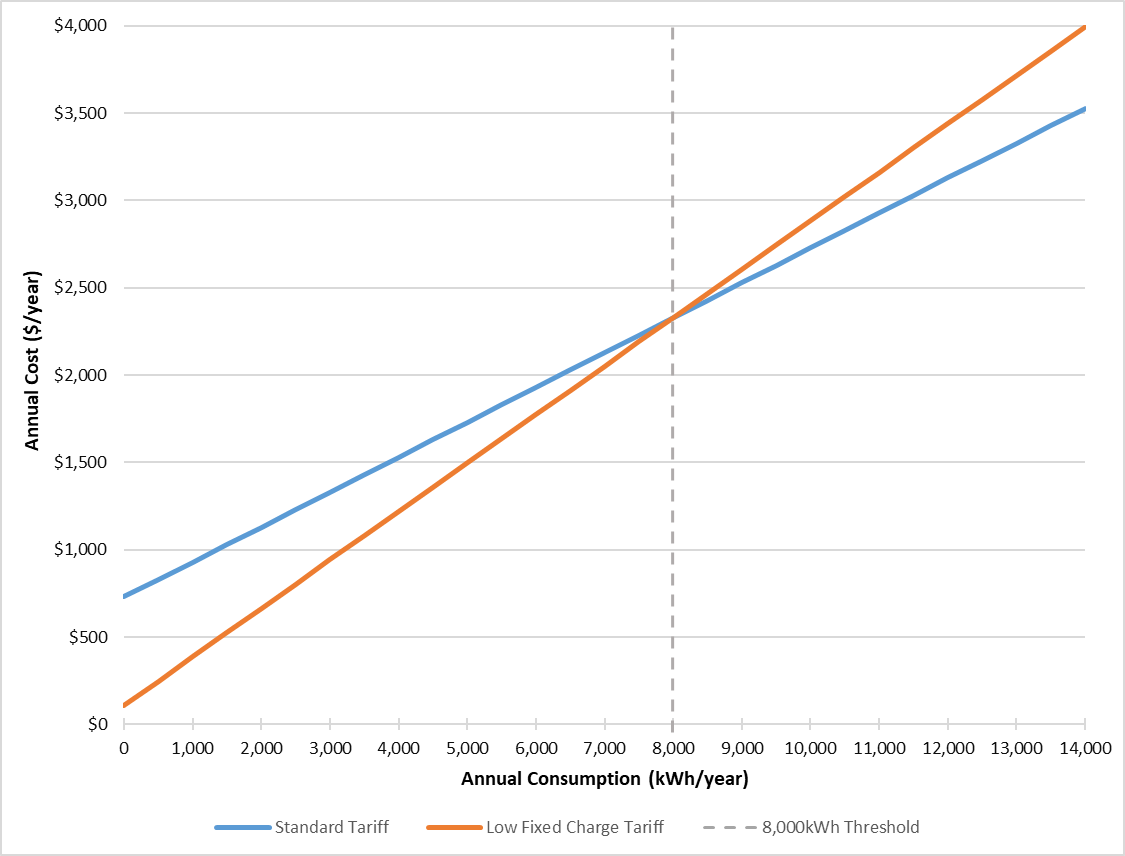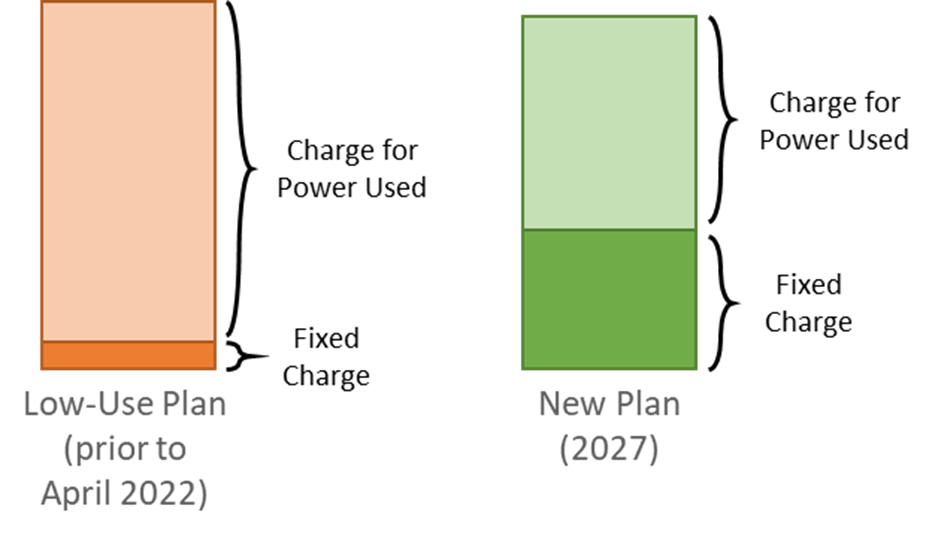[A man is looking at a computer screen and comparing 2 electricity plans – one plan is a low-use plan for households that don’t use much power, that other is a standard-use plan for high electricity use.]
[Narrator:] “When you sign up with an electricity company, you can choose from either a standard-use or a low-use plan – depending on how much electricity you think you’ll use.”
[The scene changes to a suburban street and scans past a row of houses that are connected to power lines.]
[Narrator:] “Regardless of what plan you’re on, you’ll pay a daily fixed charge that covers part of the costs of being connected to the electricity grid. You then pay for the power you actually use on top of that.”
[The next scene shows a man and a woman inside a home – they represent a household that pays low fixed charges because they don’t use much electricity.]
[Narrator:] “If you’re on a low-use plan, the amount you pay for the daily fixed charge is limited by the low fixed charge regulations. This can be a big discount towards the actual cost of providing and maintaining power to your home.”
[More people are added to the scene to show an intergenerational household. This represents a household that pays standard fixed charges because they use a lot of electricity.]
[Narrator] “But if you’re on a standard-use plan, your daily fixed charge could be quite a bit more. You may be contributing more than your fair share.”
[The scene changes again to show a scroll of paper appears on the screen that says ‘2004 regulations’.]
[Narrator:] “The regulations introduced in 2004, required power companies to offer households the option of a low-use plan, where the fixed charge was no more than 30 cents a day.”
[The next scene is a single house at night time with the lights on. Some lights turn off to show the household is trying to use less power to save money.]
[Narrator:] “It was created to help reduce bills for households with low electricity use and also encourage people to use less power.”
[The next scene shows 3 plinths with people standing on top, representing 3 different households. The first plinth shows a man and a woman. They are a low-use household that pays the low fixed charge, but a higher rate for the electricity they use. They are wearing winter clothes because they are trying to save money by using less electricity and aren’t heating their home. Their plinth goes down to show they are disadvantaged by the regulations.]
[The second plinth in this scene shows a small family who represent a household that uses an average amount of power. Their plinth stays the same height because the low fixed charge regulations do not greatly change their power bills or negatively affect their health. The last plinth shows a wealthy couple who represent a low-use household. They can afford to live in an energy-efficient house, which means they pay the cheaper low fixed charge. Their plinth rises because they are advantaged.]
[Narrator:] “While it did help some, it unintentionally harmed others.”
[The next scene goes to the home of the couple on the first plinth. They look sad and are wearing winter jackets inside.]
[Narrator:] "Many households can’t afford to reduce their power use by improving the energy efficiency of their home or installing solar panels. Instead, they limit their power use by under‑heating their homes. This can lead to cold, damp homes and more health problems.”
[As the narrator says this, the scene zooms in on the heater dial, which turns off because they can’t afford the costs of running it. There are tissues and medicine on the table as the couple get sick from living in a cold home.]
[The scene changes to the wealthy couple who are outside their home that is being built. They are having double glazed windows and new insulation installed so their home will be energy efficient and not require much power to heat.]
[Narrator:] “Households that have double-glazing and proper insulation, and can afford energy-efficient appliances or solar panels, don’t need as much electricity to heat their homes. These households don’t use as much power and can benefit from the low fixed charges.”
[The scene changes again to show a large, intergenerational family outside their home. They have an electric car and there are antenna on the roof to indicate they use a lot of electricity.]
[The next house over is run-down and looks cold and draughty. Inside there are 3 students who look cold and miserable. There are trying to heat their home with inefficient bar heaters.]
[Narrator:] “Households on the standard-use plan use more power. This could be because they are a large family, have lots of appliances like electric vehicles or have a cold and draughty house that’s hard to heat.”
[The final scene shows 5 plinths at different heights, with the figures of each household on top. The plinths are at different heights to show different levels of advantage or disadvantage caused by the low fixed charge regulations.]
[Narrator:] "The way we use electricity has changed since the regulations were introduced in 2004. Data from 2021 found about 68% of households were able to go on a low-use plan. This is making power bills more expensive for those on standard plans, which includes some households that can least afford it.”
[Narrator:] “The low fixed charge regulations are unfair to some households, which is why the government is phasing them out.”
[As she says this the plinths then move to the same height to show removing the regulations creates a more even playing field for all households.]



